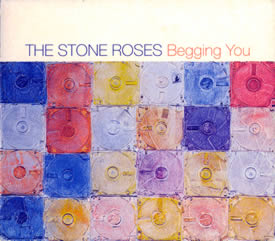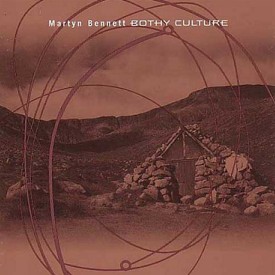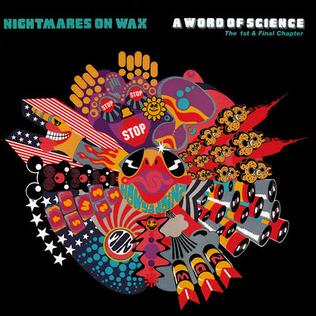House is a genre of electronic dance music characterized by a repetitive four-on-the-floor beat and a typical tempo of 115–130 beats per minute. It was created by DJs and music producers from Chicago's Black gay underground club culture and evolved slowly in the early/mid 1980s as DJs began altering disco songs to give them a more mechanical beat. By early 1988, House became mainstream and supplanted the typical 80s music beat.
Electro is a genre of electronic dance music directly influenced by the use of the Roland TR-808 drum machines, with an immediate origin in early hip hop and funk genres. Records in the genre typically feature heavy electronic sounds, usually without vocals; if vocals are present, they are delivered in a deadpan manner, often through electronic distortion such as vocoding and talkboxing. It palpably deviates from its predecessor boogie by being less vocal-oriented and more focused on electronic beats produced by drum machines.
Bouncy techno is a hardcore dance music rave style that developed in the early 1990s from Scotland and Northern England. Described as an accessible gabber-like form, it was popularised by Scottish DJ and music producer Scott Brown under numerous aliases.
Eurodance is a genre of electronic dance music that originated in the late 1980s in Europe. It combines many elements of rap, techno and Eurodisco. This genre of music is heavily influenced by the use of rich vocals, sometimes with rapped verses. This, combined with cutting-edge synthesizers, strong bass rhythm and melodic hooks, establishes the core foundation of Eurodance music.

"Begging You" is a song by English rock band the Stone Roses, released as the final single before their initial break-up a year later, and was the third single from their second album, Second Coming (1994). "Begging You" was released in the United Kingdom and Australia, peaking at number 15 on the UK Singles Chart.

Basic Channel is a German music duo and record label, composed of Moritz von Oswald and Mark Ernestus, that originated in Berlin in 1993. The duo have also worked under other names, including Rhythm & Sound and Maurizio, and have founded offshoot label imprints such as Chain Reaction and Main Street. Their releases in the 1990s are regarded as pioneering examples of the minimal and dub techno subgenres.

"Where Is the Feeling?" is a song by Australian singer-songwriter Kylie Minogue from her fifth studio album, Kylie Minogue (1994). The song was written by Wilf Smarties and Jayn Hanna, while production was handled by Brothers in Rhythm. It was released on 10 July 1995 as the third and final single from the album, by Deconstruction and Mushroom Records, seven months after the release of the second single. A new version was recorded for the single release, featuring spoken vocals by Minogue.

"Beautiful Life" is a song by Swedish band Ace of Base, released on October 20, 1995 from their second album, The Bridge (1995). In North America, it was the first single released from the album; in Europe, it followed "Lucky Love" as the second single. Co-written by band member Jonas Berggren and produced by him with Denniz Pop and Max Martin, the single reached number 15 on both the US Billboard Hot 100 and the UK Singles Chart in December 1995. It reached number one on the Canadian RPM Dance/Urban chart and Billboard's Hot Dance Club Play chart. In 2017, BuzzFeed ranked "Beautiful Life" number 51 in their list of The 101 Greatest Dance Songs Of the '90s.
Paul Mounsey is a Scottish musician, composer, arranger and record producer.

Solar Shears is the third studio album and fourth album overall by Scottish Celtic fusion band Shooglenifty. After the critical acclaim given to their underground second album A Whisky Kiss (1996), the band left Greentrax Recordings and signed to Vertical Records in the UK and Compass Records in the US and hired long time producer Jim Sutherland to produce their new album. The album sees the band expand their self-described "acid croft" sound, featuring a wide range of musical influences such as worldbeat, Eastern music, African music, psychedelic music, bluegrass, breakbeat and techno fused with a traditional Scottish Celtic music sound. With this album, Sutherland introduced many unorthodox approaches to the band's music, including looped beats, scratching, electro-atmospherics and sampled 'discovered sounds' from industrial clanks and rumbles to snatches of telephone conversation and recorded pelican crossing announcements.
Reggae fusion is a fusion genre of reggae that mixes reggae and/or dancehall with other genres, such as pop, rock, hip-hop/rap, R&B, jazz, funk, soul, disco, electronic, and Latin music, amongst others.

Bothy Culture is the second studio album by the Scottish Celtic fusion artist Martyn Bennett, released in October 1997 on the Rykodisc label. After winning critical acclaim for his debut album Martyn Bennett (1996), Bothy Culture builds upon that album's mixing of Scottish Celtic music with farther, international folk music styles and contemporary electronic music. The album celebrates and draws upon the music of Bennett's native Gaeldom as well as the music of Islam and Scandinavia, with Bennett finding and emotionally connecting to the similarities between the geographically dispersed styles. It mixes the styles with contemporary electronic music such as breakbeat and drum and bass.

A Word of Science is the debut studio album by British electronic producers Nightmares on Wax. Released by Warp Records in September 1991, it is the act's only album as a group before it became a solo vehicle for George Evelyn. Evelyn nonetheless recorded and produced the album alone, incorporating samples and elements from demo tapes he made in the late 1980s. Although Nightmares on Wax debuted with two well-received techno singles in 1989-1990, A Word of Science is eclectic and largely moves the act towards a more mellow style influenced by funk, soul and hip hop, while still incorporating techno, drum and bass, and house styles.
Bongshang are a Scottish band from Shetland, who fuse traditional Shetland and folk styles with rock, funk, electronica and contemporary production techniques. They have been likened to Celtic fusion artists such as Shooglenifty and Martyn Bennett.
Techno is a genre of electronic dance music which is generally produced for use in a continuous DJ set, with tempos being in the range from 120 to 150 beats per minute (BPM). The central rhythm is typically in common time (4/4) and often characterized by a repetitive four on the floor beat. Artists may use electronic instruments such as drum machines, sequencers, and synthesizers, as well as digital audio workstations. Drum machines from the 1980s such as Roland's TR-808 and TR-909 are highly prized, and software emulations of such retro instruments are popular.
Dub techno is a subgenre of electronic music that originated in the early 1990s, blending the repetitive, minimal structures of techno with the echo-laden, spacey production techniques of dub music. It is notable for its deep, atmospheric soundscapes, layers of elaborate basslines, slowly developing musical phrases featuring heavy delay and reverb effects. Vocals are either absent, or inspired by dub and ambient music.

Emit Ecaps is the third album by English techno producer Jonah Sharp under his pseudonym Spacetime Continuum. It was released in February 1996 on Reflective Records in the United Kingdom and on Astralwerks in the United States. After establishing himself as a techno producer but then moving to an ambient style on his previous album Sea Biscuit (1994), Sharp's music on Emit Ecaps balances his techno and ambient styles with influences of drum and bass and jungle music. The name of the album reverses the term 'space time'. Emit Ecaps was a radio success and received acclaim from music journalists who praised Sharp's change in direction. The album was followed in November 1996 by Remit Recaps, a remix album of material from Emit Ecaps, created with the involvement of several producers.

Come On In is a remix album by Delta blues guitarist R. L. Burnside, released by the label Fat Possum in 1998. Largely produced by Tom Rothrock, the album was a departure for Burnside in that it fuses his blues guitar work with dance and electronic music, incorporating sampling and looping techniques. Burnside was originally skeptical of the idea, but enjoyed the finished product. Although the album's fusion of styles was deemed unusual by critics, it received acclaim from music journalists and showed respectable sales, becoming the best-selling album distributed by Epitaph Records in early 1999. The album's sound was explored by Burnside in his later works.

"Destination Eschaton" is a song recorded by Scottish band the Shamen, released in August 1995 by One Little Indian as the first single from the band's sixth album, Axis Mutatis (1995). The song was written by Colin Angus and Richard West, and features vocals by American guest vocalist Victoria Wilson James. It was a hit in several countries in Europe, peaking within the top 10 in Finland (6) and Scotland (9). In the UK, it peaked at number 15 in its first week at the UK Singles Chart, on 13 August 1995. In the US, "Destination Eschaton" reached number 14 on the Billboard Hot Dance Club Play chart. A music video was produced to promote the single, directed by German director Nico Beyer and William Latham, featuring the band performing aboard a spaceship.










